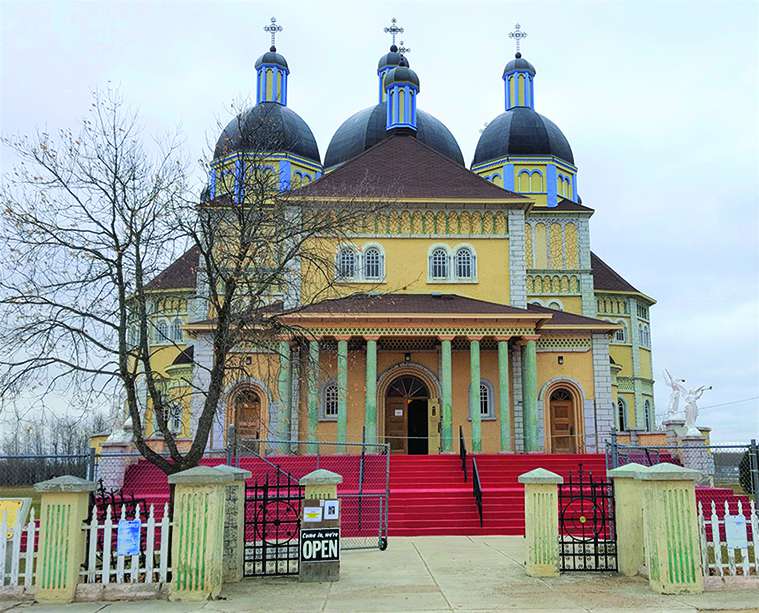By Christian Cassidy
If you haven’t already visited Immaculate Conception Ukrainian Catholic Church at Cooks Creek, it definitely needs to be on your Manitoba historic sites bucket list.
The community of Cooks Creek is in the Rural Municipality of Springfield and situated east of Birds Hill Park on Provincial Road 212. Its other amenities include the Cooks Creek Heritage Museum and a new community centre.
The story of the church is as much the story of the man who designed and built it, Father Philip Ruh.
Born in the Alsace-Lorraine region of France in 1883, Ruh trained as a priest in Holland and in 1913 was sent as a missionary to the Catholic Ukrainian communities of Northern
Alberta. One of the basic needs of many of the congregations he encountered was a church building, so despite having no formal architectural training he began designing and building them. One of the first churches credited to Ruh is the 1917 Holy Trinity Ukrainian Catholic Church in Leduc, Alberta.
By 1924, Ruh was serving in Manitoba and found himself assigned to Cooks Creek in 1930. In fact, area Ukrainian Catholics had petitioned the church to have Ruh sent there so that they could get a new church to replace two small, wooden buildings that had outlived their usefulness.
Work began on the new church in 1930. It was initially called St. John the Baptist after one of the church buildings it was replacing.
In summer 1937, Winnipeg Tribune columnist Lillian Gibbons visited Ruh at Cooks Creek. She found that the congregation worshipped in the completed basement portion of the building while above ground, “… it is in its concrete and hollow tile state, but the pillars of the portico give it the dignity of a Greek temple.”
When Gibbons asked why construction was taking so long, Ruh joked, “I am the architect, the contractor, the boss, the helper and the collector.” He explained that he worked on the building six days a week with volunteer labour from parishioners and that they only bought materials when they had donations in the bank. That way, Ruh said, the congregation would end up with a church for around $30,000, mortgage free, that would have cost up to $400,000 if paid labour was used.
The church was completed in 1938, though finishing touches and the painting and decoration of the interior carried on for years after. The church was finally consecrated at a ceremony on July 27, 1952 and its name was formally changed to Immaculate Conception.
When viewed from above the church is in the shape of a cross, something common for Ukrainian Catholic churches. It boasts nine domes of various sizes and can hold around 1,000 people.
Ruh used a variety of materials and architectural styles to create his own unique style that has been dubbed “prairie cathedral.” Another feature of his churches, particularly at Immaculate Conception, is the attempt to emulate the grandeur of old European churches on the budget of a small farming community. Many of the finishes, such as those marble pillars Gibbons eluded to, are simply painted to look like marble.
While toiling away at Cooks Creek, Ruh found time to design churches for other communities. He is credited with designing around 30 of them, most on the prairies and many still standing today.
Ruh’s final and most personal project was the construction of the Our Lady of Lourdes Grotto adjacent to Immaculate Conception Church. He wanted to build a holy site dedicated to the Virgin Mary where Ukrainian Catholics could come on pilgrimage. It is modelled on the Our Lady of Lourdes Grotto in Lourdes, France where Ruh had visited at least three times in his life.
Construction began on the grotto in 1954 when Ruh was 71 years old. It was still unfinished in 1960 when he fell ill and construction ground to a halt. Ruh died in 1962.
The local chapter of the Knight of Columbus vowed to finish the grotto based on Ruh’s rudimentary drawings. Church officials at Lourdes, France sent a stone from their grotto as a source of inspiration and the Cooks Creek grotto was completed in 1964.
Immaculate Conception Ukrainian Catholic Church is open to visitors from 12:00 pm to 6:00 pm on weekends from the Victoria Day Weekend to the end of October. The 65th annual pilgrimage to the grotto takes place August 16 – 18, 2019.
Christian writes about local history on his blog, West End Dumplings.



